The U.S. Army positions itself as “Army Strong,” an expression that can go beyond distinguishing the men and women in the service branch who spend long nights on patrol or parachute out of airplanes into combat.
“Army Strong” can also describe one of The University of Akron’s most enduring programs – Akron Army ROTC, which turns 100 years old this academic year.
In 1918, just a month after the end of the First World War, UA President Dr. Parke Kolbe and the Board of Trustees applied to the U.S. Department of War to establish a reserved officers’ training corps unit at the University. Shortly thereafter, the Board approved a resolution to agree to the mandates and responsibilities set by the War Department in order to maintain its new ROTC program.
Striving to be the best
Over the past century, Akron ROTC, also known as the 42nd Ohio Volunteer Battalion, has continued to meet, and even exceed, those mandates. In fact, Akron ROTC still encompasses a four-year academic curriculum, annual summer training camps at Fort Knox, and cadets still train on Buchtel Field on Brown Street where yesteryear’s cadets once trained.
“Our program has performed well to meet the standards of the U.S. Army because we want to be the best in the country,” said Lt. Col. Trevor S. Liverpool, commander of Akron ROTC and chair of the Military Science and Leadership Department. “Akron ROTC was recognized this summer as the top-performing program in the critical area of cadet evaluations in our brigade. And last year, an Akron cadet was the distinguished graduate for Airborne. So, the determination to be among the best in the country has contributed to Akron ROTC’s success and longevity.”
Compulsory start
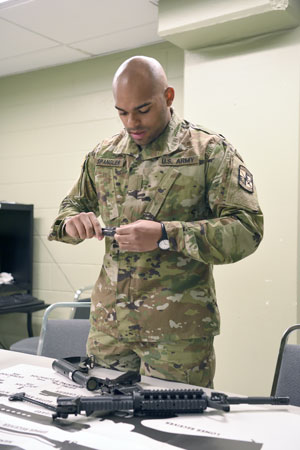
Cadet Alex Spangler, a senior majoring in respiratory therapy, demonstrates the proper way to safely disassemble and maintain a rifle during weapons familiarization and safety training in Schrank Hall South at a leadership lab.
UA’s program, originally proposed as a volunteer course, was compulsory for all freshman and sophomore male students from fall 1919 until 1968. The four-year curriculum consisted of field fortifications, hippology (the study of horses), field sanitation, map reading and infantry tactics. Cadets began attending summer camp at Fort Knox in Kentucky in 1923, and most new officers attended six months of full-time training before serving part-time in the Army Reserve.
After World War II, the U.S. Air Force established a separate ROTC detachment at UA in 1947. (In June 2005, the detachment was integrated with Kent State University’s Air Force ROTC program.) Also, veterans took advantage of the Servicemen’s Readjustment Act of 1944 (aka the G.I. Bill) to fund their higher education at Akron ROTC, which commissioned its 1,000th graduate in 1955.
Female students held supportive roles in auxiliary groups in the early days of Akron ROTC, but they didn’t participate as cadets until the fall of 1970. Anne Marie (Connell) Freund ‘77 was the program’s first female graduate and the first female cadet commander of troops at UA. Female cadets now participate from across all majors and make up 41 percent of student participation in Akron ROTC.
Career launcher
Today, Akron ROTC has 112 undergraduate and graduate students, many of them pursing degrees in physical sciences, nursing, business and liberal arts.
ROTC is a college elective program where cadets can pursue the degree of their choice while learning valuable leadership skills. Upon completion of a degree, cadets are commissioned as second lieutenants in the Army and receive an average starting salary of about $51,000. Graduates can choose to serve in active duty, the Army Reserve or the National Guard.
Over the past 15 years, UA has supplemented funding from the U.S. Army with slightly more than $4 million in generous scholarships that assist with expenses such as tuition, fees and books.
“Akron ROTC provides unmatched apprenticeship in leadership; students are given a chance to challenge themselves to meet standards in accordance with the Army’s Leadership Requirements Model,” said Liverpool. “This model focuses on not only what a leader knows, but also what a leader does and what attributes they possess. Akron ROTC is an immersive program, from freshman all the way to senior years. It is designed to give the students and cadets leadership experience in real-life situations, so they become agile and adaptive. We produce some of the best cadets in the nation.”
Related
Photo gallery
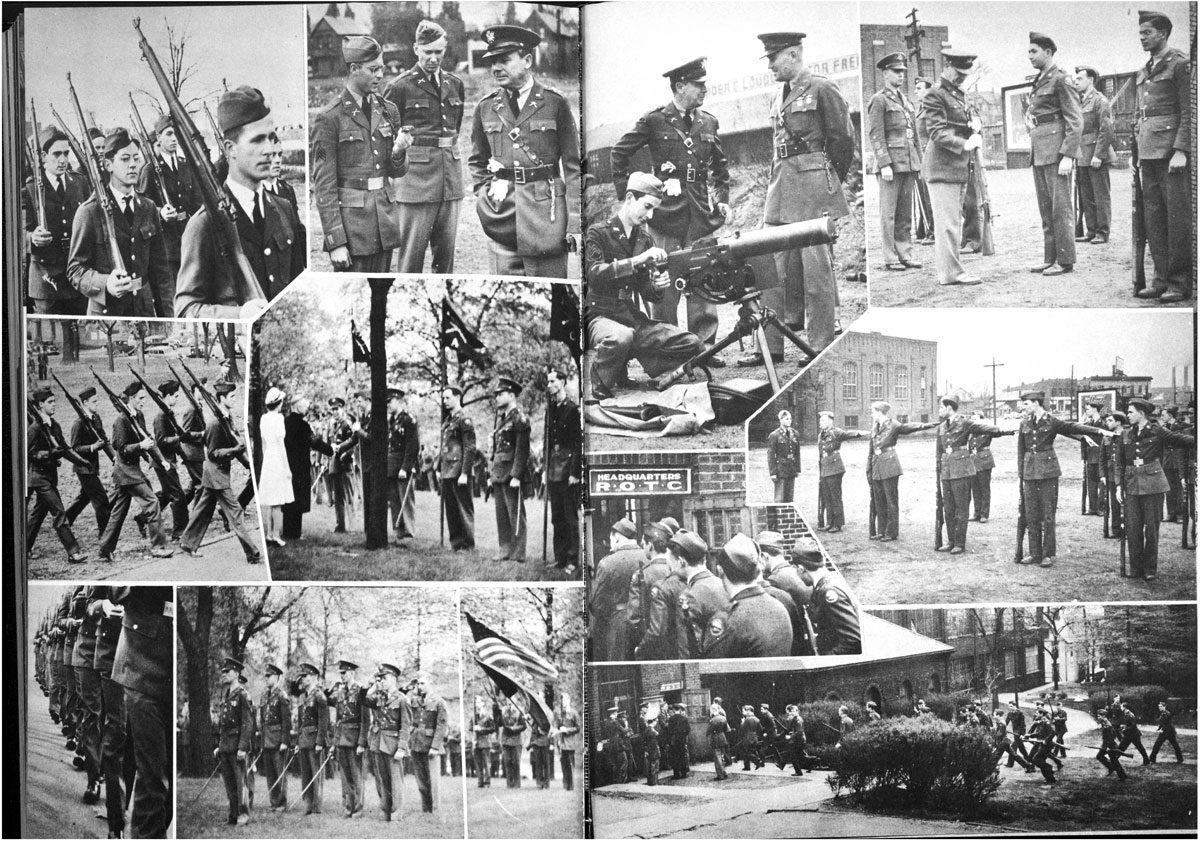
This page from UA’s 1940 yearbook, The Tel-Buch, shows images of Akron ROTC cadets from 78 years ago.
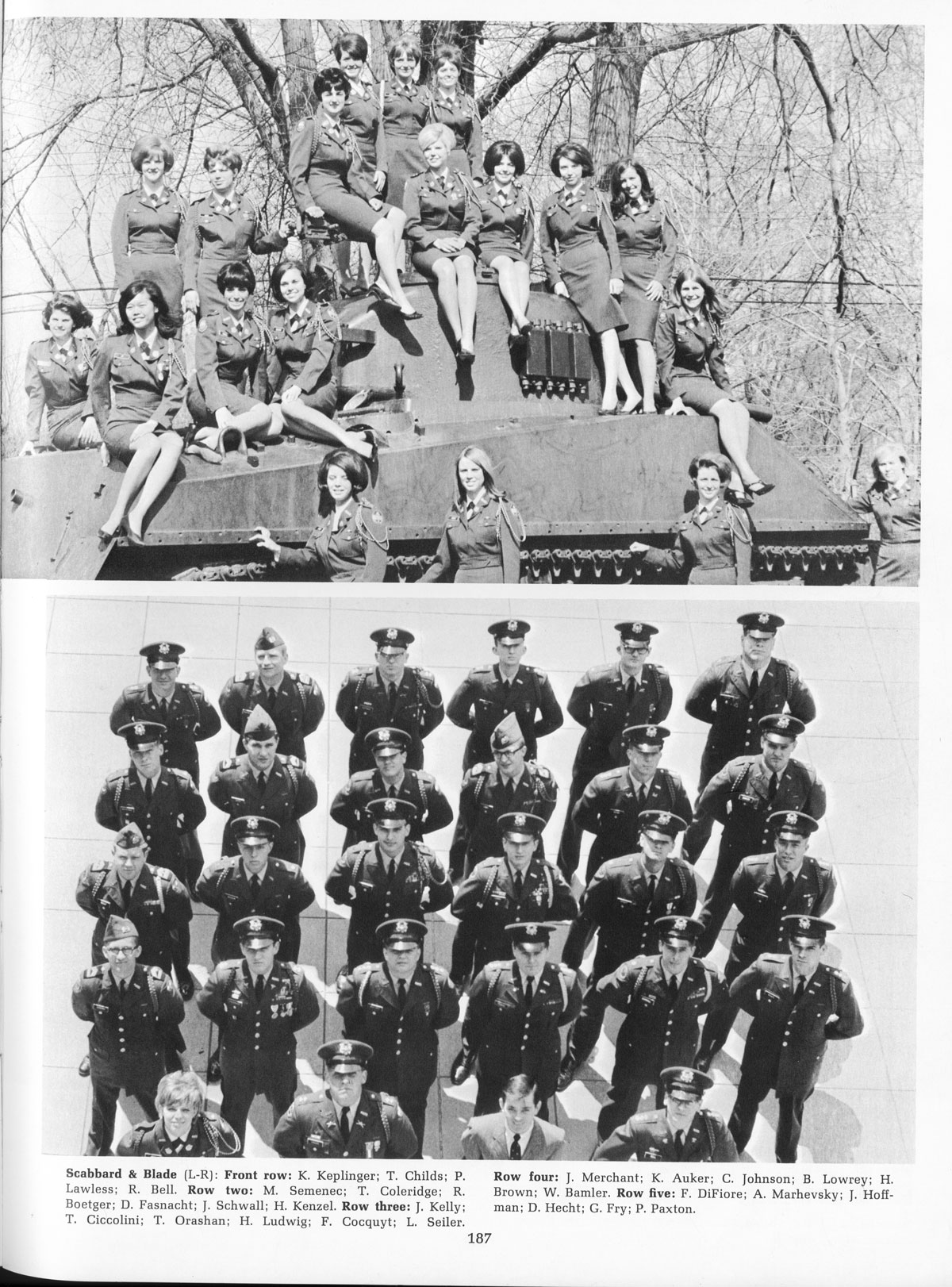
As seen in this page from UA’s 1963 yearbook, The Tel-Buch, women were able to hold auxiliary roles in Akron ROTC. It wasn’t until 1970 when women were allowed to fully participate in Akron ROTC.
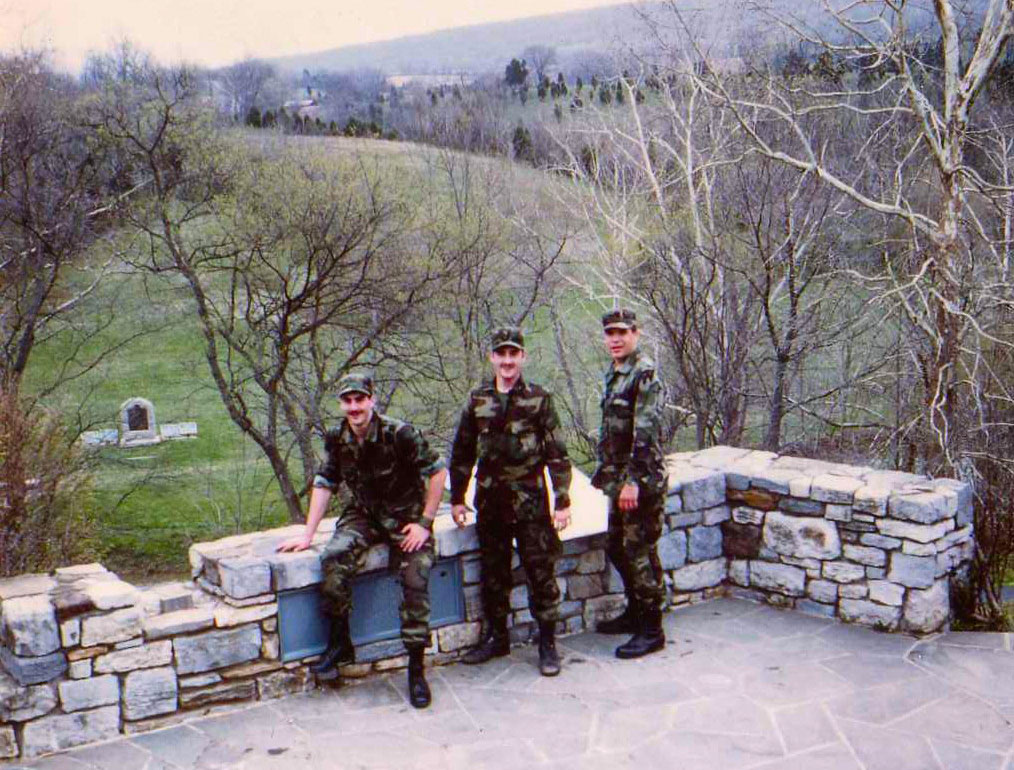
In this photo from the mid 1980s, alumnus Terry Michaels ’86, center, overlooks the battlefields of Gettysburg, PA, with other Akron ROTC cadets. Michaels and other members of Pathfinders, an ROTC extracurricular organization, hiked the Appalachian Trail for four days and then conducted a battlefield walk and ride at the Gettysburg National Military Park.
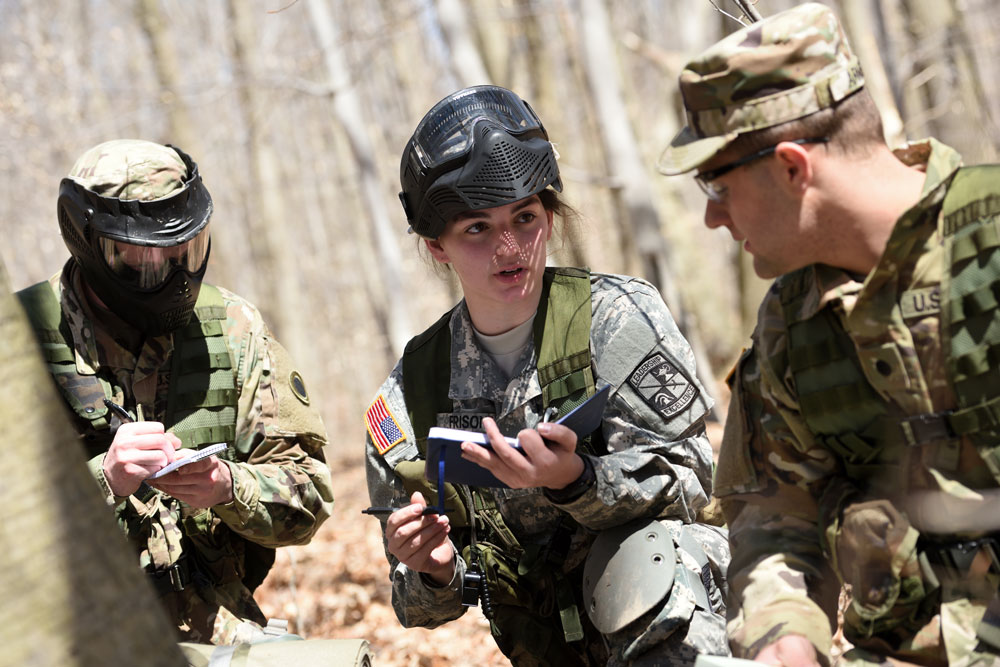
Cadet Maria Frisone, a senior nursing major, is conducting troop leading procedures during her leadership rotation, while participating in the spring 2018 Field Training Exercise. The training was conducted at the Ohio Army National Guard’s James A. Garfield training facility in Ravenna.
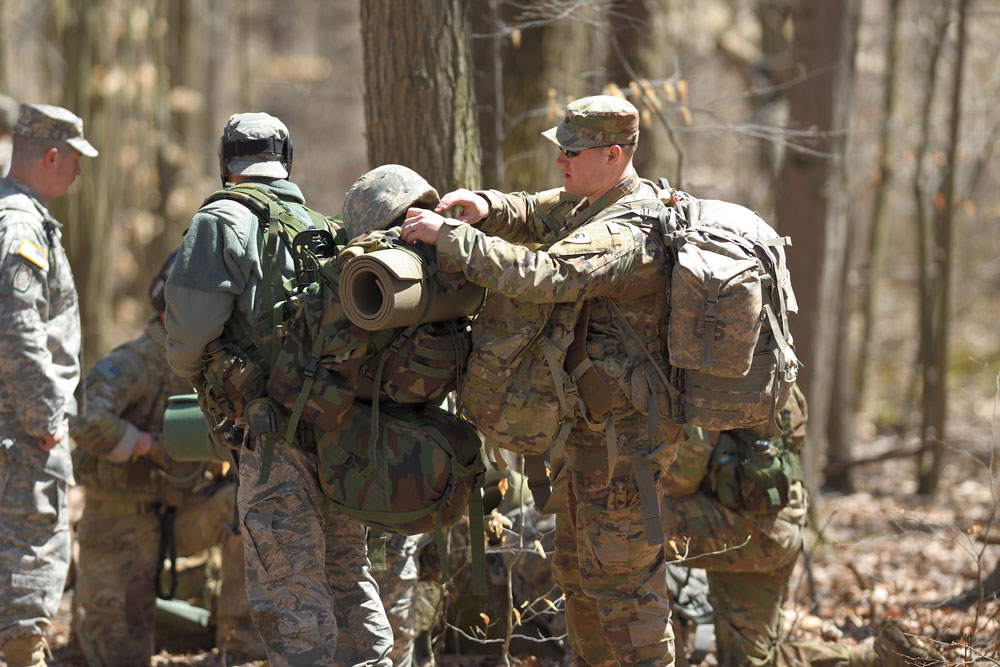
A student assists a teammate in conducting pre-execution checks during the spring 2018 Field Training Exercise. The training was conducted at the Ohio Army National Guard’s James A. Garfield training facility in Ravenna.
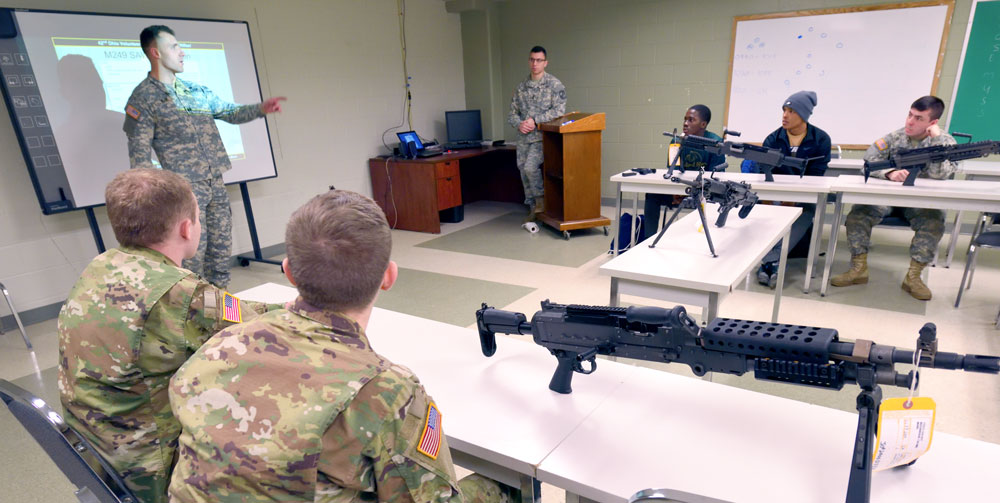
Cadets Jerry Klue and Logan McNally, who both graduated in May, are leading the classroom portion of weapons familiarization and safety training in Schrank Hall South during a leadership lab.
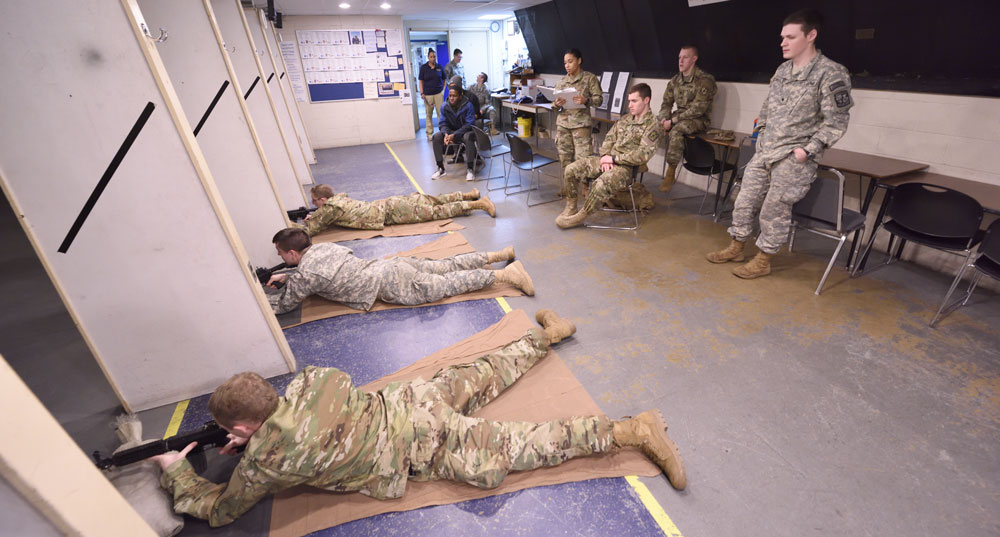
Cadets conduct "dry fire" (no ammunition) exercises at the UA rifle range in preparation for safe operation of the rifle during weapons familiarization and safety training in Schrank Hall South at a leadership lab.
Q&A with three ROTC and Army veterans
Anne Connell Freund ‘77

Home: Cuyahoga Falls
Occupation: Executive Vice President of Operations, Oriana House
Military experience: Active duty 1977-1981, 18th Military Intelligence Group, Fort Bragg, N.C.; Reserve Duty, 1985-1993, U.S. Forces Caribbean and U.S. Forces CINCLANT
Why did you join The University of Akron’s ROTC program? “I Joined ROTC because my father was in the military, and I was interested in seeing for myself what the military was like. It was the first year that women were allowed to be in the Army as they were about to retire the Women’s Army Corp.”
What did you enjoy most from your experience in the program? “I enjoyed the many new experiences that were happening. The rescue of the Iran Hostages and the recovery in Guyana are a couple that I had involvement with.”
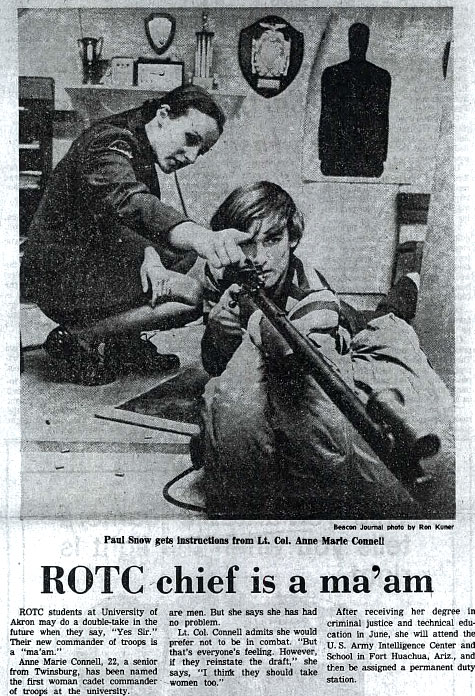
Alumnus Anne Connell Freund ’77 is the subject of this Akron Beacon Journal article from 1977 that features her accomplishments as Akron ROTC’s first female graduate and the program’s first female commander of cadets.
What would you say was the biggest challenge? “The biggest challenge was having to prove that women belonged in the Army and could do the job well.”
Upon graduation, did you go into active duty or pursue a civilian career? “I went on active duty for four years with the 18th Combat Intelligence Group at Fort Bragg.”
Out of all the things you learned in ROTC, what is the biggest lesson you still benefit from today? “The biggest lesson I learned was how important it is to trust your team, especially your non-commissioned officers (NCO).”
If a student was considering joining UA’s ROTC program, what would you say to that person? “Joining ROTC taught me leadership skills that have been so valuable to me in all the things that I have been involved in my life. The Army has also left me with lifetime friends.”
Geri Ann Frisone ‘87
 Home: Cleveland
Home: Cleveland
Occupation: Human resources systems manager
Military experience: Served in the U.S. Army (active and reserve) as an Adjutant General officer. Assignments included the 203d Personnel Services Company, Fort Richardson, Alaska, and the Network Enterprise Technology Command (NETCOM), Fort Huachuca, Arizona in addition to working at the AG School at Fort Benjamin Harrison, Indiana.
Why did you join The University of Akron’s ROTC program? “I was fortunate to be granted a four-year Army ROTC scholarship which could have been used at any program nationally. Having grown up in Canton, I wanted to go to school locally and was happy to be accepted into The University of Akron Army ROTC program.”
What did you enjoy most from your experience in the program? “The comradery with the others in the program and the development of life-skills including: fundamentals of leadership, problem-solving, first aid, rifle marksmanship, land navigation, rappelling, map orienteering and physical fitness.”
What would you say was the biggest challenge? “Perseverance, developing my own self-confidence and pushing through difficult situations (physical, mental and fiscal) to achieve success both as a college student and cadet.”
Upon graduation, did you go into active duty or pursue a civilian career? “I was commissioned as a Regular Army officer and served four years on active duty before transferring to the U.S. Army Reserve as an Individual Mobilization Augmentee (IMA) and beginning my civilian career in human resources.”
Out of all the things you learned in ROTC, what is the biggest lesson you still benefit from today?
“Perseverance: There are going to be times in your life when you question what you are doing and if you should quit. By enduring tough situations in training, you learn that you can get through it and come out better in the end.
Adaptability: Planning is important, but the willingness and ability to adapt when facing reality is key. Agility wins.
Teamwork: Knowing and performing your role on the team is critical.
Inclusion: A diverse and inclusive workforce is fundamental to long-term success.
Continuous Learning: The importance of training and development; the benefits of learning from your successes and failures (after action review). Everyone will make mistakes. What's important is that we take responsibility, learn from them and don't make excuses — make corrections.
Coaching: Specific, timely feedback is important to skill building and relationship building.
Leadership may be inherent in the position you hold, but respect is earned.”
If a student was considering joining UA’s ROTC program, what would you say to that person? “Absolutely, you should do it! As a former cadet and a human resources professional, I would advocate that all college students could benefit from enrolling in the ROTC program if only for one year. The lessons in leadership, problem solving, discipline, time management and communications will last a lifetime. But, be sure to do your due diligence before signing a contract. Speak to current and former students and faculty; have your questions prepared in advance. Make sure you understand the service obligation but also the differences in additional benefits offered by all universities you’re considering.”
Terry Michaels ‘86
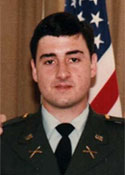 Home: Coventry Township
Home: Coventry Township
Occupation: U.S. Army Retired and currently a Department of Defense Employee at The University of Akron Army ROTC program
Military experience: Commissioned as a second lieutenant out of the UA Army ROTC program and served 24 years in the Army before retiring in 2010. Served in Germany for 6 ½ years as well as temporary duty in Japan, Korea and Hawaii. (More information here.)
Why did you join The University of Akron’s ROTC program? “My father was a veteran of WWII. I wanted to see if ROTC would be a good fit for me and to give me a little experience of leadership as I pursued my degree here at Akron. During the first year of ROTC, I competed for and received a three-year ROTC scholarship which covered the full tuition and fees of the University.”
What did you enjoy most from your experience in the program? “I liked the camaraderie of the students in the program and the leadership instruction and experiences I received while in the program. I was an accounting major and the ROTC program provided a lot of experiential learning in the leadership. I have used may of the lessens learning in ROTC throughout my career as an Army officer and since retiring, as a member of the Army ROTC team here at Akron.”
What would you say was the biggest challenge? “My biggest challenge within the program was balancing my time between work, academics and the ROTC requirements. The lessons I learned in time management balancing multiple assignments and responsibilities definitely helped me in life to meet or exceed requirements placed upon me as a leader.”
Upon graduation, did you go into active duty or pursue a civilian career? “I entered the active Army and served 24 years. Service included time in the continental United States, Europe, Asia and the Middle East.”
Out of all the things you learned in ROTC, what is the biggest lesson you still benefit from today? “The ability to deal with a wide range of people and cultures. It has immensely helped me in all areas of serve while in the Army and since retirement from the active Army.”
If a student was considering joining UA’s ROTC program, what would you say to that person?
“ROTC is a great opportunity to learn about your own leadership and develop your skills to be a more effective leader. The first two years of ROTC are an introduction to the Army and a foundation of what leadership theory is. There is no commitment for service during the first two years of ROTC. Regardless of the major here at Akron, ROTC will provide students a grounding in leadership that will help them stand out from their peers as a confident leader and manager in group projects.
Today, with so few citizens having experience in service in the armed forces of the United States, it allows students to gain a little experience and understanding of the armed forces without having to actively serve or attend any additional military training. It also allows the students to interact with currently serving members of the Army which many have never had the opportunity in the past.
Finally, if they enjoy the program, it provides an opportunity to commission as an officer just like the graduates from West Point. Students who commission through ROTC will have the same duty, rank, authority and responsibilities as the graduates of the US Military Academy at West Point.”
